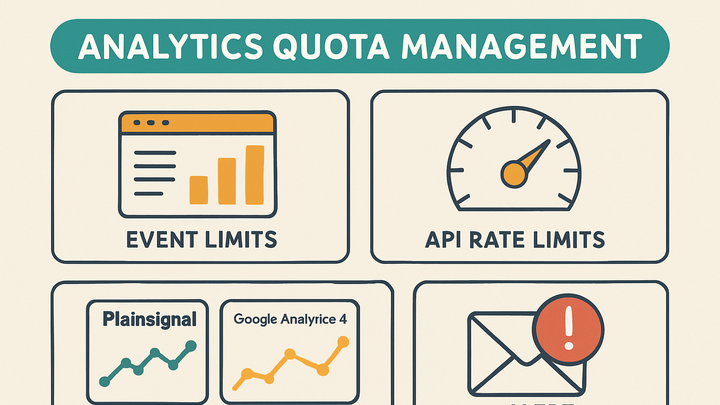Published on 2025-06-22T04:44:56Z
What is Quota in Analytics? Examples of Quota
Quota in analytics refers to limits set by analytics platforms to control resource usage, ensure system stability, and manage costs. These limits can apply to data collection (events, pageviews), API requests, data exports, and storage or retention periods. For example, Google Analytics 4 (GA4) enforces quotas on Measurement Protocol API calls and event parameter usage, while PlainSignal offers cookie-free analytics with generous free-tier quotas for pageviews and events. Implementing quotas helps prevent abuse, maintains consistent performance, and provides predictable billing.
Example PlainSignal tracking code:
<link rel="preconnect" href="//eu.plainsignal.com/" crossorigin />
<script defer data-do="yourwebsitedomain.com" data-id="0GQV1xmtzQQ" data-api="//eu.plainsignal.com" src="//cdn.plainsignal.com/plainsignal-min.js"></script>
Quota
Limits set by analytics tools on data collection and API usage to ensure performance, security, and cost management.
Definition and Scope of Quota in Analytics
Quotas define the boundaries within which analytics tools operate. They specify how much data can be collected, how many API requests can be made, and how long data can be retained. These limits ensure fair resource allocation, system reliability, and predictable costs for both providers and customers. By understanding quota definitions, analysts can design efficient tracking strategies and avoid service disruptions.
-
Types of quotas
Analytics platforms use various quota categories to manage resources:
-
Data collection quota
Limits on the number of events or hits processed per time period (e.g., daily or monthly).
-
Api request quota
Caps on the number of API calls allowed per second, minute, or day to prevent overload.
-
Data retention quota
Specifies how long collected data is stored before deletion or archiving.
-
-
Purpose of quotas
Understanding why quotas exist helps teams align tracking plans with service capabilities.
-
System stability
Prevents spikes and abuse from impacting platform performance.
-
Cost management
Offers predictable billing by capping resource usage.
-
Quota Examples in PlainSignal and GA4
Different analytics solutions implement quotas in unique ways. Here are practical examples from PlainSignal and GA4, illustrating daily and API rate limits you might encounter.
-
PlainSignal free tier quotas
The PlainSignal free plan allows up to 100,000 events and pageviews per month with no cookies, ideal for small sites.
-
GA4 measurement protocol api quotas
GA4 enforces a quota of 2 million events per day per project and limits to 5 requests per second, with exponential backoff on quota errors.
-
GA4 event parameter limits
GA4 caps event parameters to 25 per event and allows up to 500 distinct event names per property per day.
Monitoring and Managing Quotas
Proactively tracking quota usage helps ensure uninterrupted analytics operations. Use built-in dashboards, set up alerts, and optimize data strategies to stay within limits.
-
Monitoring usage
Review quota dashboards in GA4 Admin or PlainSignal’s metrics page to track events, hits, and API calls in real time.
-
Optimizing event strategy
Consolidate similar events, remove low-value tracking, and adjust sampling settings to reduce quota consumption.
-
Request batching and sampling
Combine multiple events into batched API calls or apply sampling to lower request counts and avoid rate limit errors.
Best Practices and Troubleshooting
When quotas are exceeded, it’s crucial to handle errors gracefully and plan for scale. Follow these best practices to mitigate interruptions.
-
Handling quota exceedance
Implement retry logic with exponential backoff, fallback to backup analytics solutions, and notify stakeholders when limits are reached.
-
Scaling and upgrading
Assess growth patterns, upgrade to higher-tier plans for increased quotas, or request custom limits from your analytics provider.
